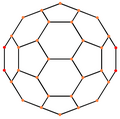Cartesian coordinates
Let  be the golden ratio. The 12 points given by
be the golden ratio. The 12 points given by  and cyclic permutations of these coordinates are the vertices of a regular icosahedron. Its dual regular dodecahedron, whose edges intersect those of the icosahedron at right angles, has as vertices the points
and cyclic permutations of these coordinates are the vertices of a regular icosahedron. Its dual regular dodecahedron, whose edges intersect those of the icosahedron at right angles, has as vertices the points  together with the points
together with the points  and cyclic permutations of these coordinates. Multiplying all coordinates of the icosahedron by a factor of
and cyclic permutations of these coordinates. Multiplying all coordinates of the icosahedron by a factor of  gives a slightly smaller icosahedron. The 12 vertices of this icosahedron, together with the vertices of the dodecahedron, are the vertices of a pentakis dodecahedron centered at the origin. The length of its long edges equals
gives a slightly smaller icosahedron. The 12 vertices of this icosahedron, together with the vertices of the dodecahedron, are the vertices of a pentakis dodecahedron centered at the origin. The length of its long edges equals  . Its faces are acute isosceles triangles with one angle of
. Its faces are acute isosceles triangles with one angle of  and two of
and two of  . The length ratio between the long and short edges of these triangles equals
. The length ratio between the long and short edges of these triangles equals  .
.
This page is based on this
Wikipedia article Text is available under the
CC BY-SA 4.0 license; additional terms may apply.
Images, videos and audio are available under their respective licenses.


































































































